You’ve put in the work, wrote the perfect caption, picked a scroll-stopping image, and you know you did because you’ve studied your audience and their interests. But your post still flops. Why?!
It might not be your content. It might be your timing.
Instagram’s algorithm prioritizes engagement within the first hour, so knowing when your audience is most active is quite literally the difference between your post getting seen and it being hidden in obscurity forever.
In today’s article, we’ll show you the real data and strategy behind posting times that actually work.
- Best times to post on Instagram, based on global data
- Best time to post by day of the week
- Best time to post on Instagram by industry
- Best time to post on Instagram by audience demographics
- Does time zone affect Instagram engagement?
- How to find your best time to post on Instagram
- Free and paid tools to discover the best time to post
- Best posting time for different Instagram formats
- Best time to post on Instagram by location
- Final thoughts
Best times to post on Instagram, based on global data
Based on global 2024-25 data compiled from multiple sources, each of which individually studied millions of Instagram posts, here’s a breakdown of the best times to post on Instagram:
| Day | Time |
|---|---|
| Monday (best day) | 5 a.m., 10 a.m. – 4 p.m. |
| Tuesday | 5 a.m., 10 a.m. – 2 p.m. |
| Wednesday | 5 a.m., 10 a.m. – 4 p.m. |
| Thursday | 4 a.m. – 5 a.m., 10 a.m. – 3 p.m. |
| Friday | 6 a.m. – 8 a.m., 11 a.m. – 2 p.m. |
| Saturday (worst day) | 7 a.m., 9 a.m. – 4 p.m., 7 p.m. |
| Sunday | 10 a.m. – 12 p.m., 3 p.m., 11 p.m. |
Best time to post by day of the week
Let’s clear something up: there’s no one-size-fits-all “magic hour” for Instagram. But there are patterns. Engagement tends to follow people’s routines: when they wake up, take breaks, or wind down. So while your audience might be unique, the data still reveals useful trends by day.
That said, the “best time to post” depends on whose data you’re working off of. Every study returns different results, so we’ll compile them all and give you the full analysis.
Monday
You might think Monday is a tough day to grab attention; people are swamped, inboxes are full, and to-do lists are long. But the data tells a different story.
In fact, Monday consistently shows the highest engagement rates across nearly all industries. After the weekend, people return to their routines, and that includes checking social media.
| Source | Best time to post on Monday |
|---|---|
| Sprout Social | 10 a.m. – 4 p.m. |
| Hootsuite | 3 p.m. – 9 p.m. |
| Later | 5 a.m. and 11 p.m. |
| Hopper HQ | 12 p.m. – 2 p.m. |
| Buffer | 3 p.m. – 6 p.m. |
| Analyzify | 7 a.m. – 8 a.m., 4 p.m., 8 p.m. |
| SocialPilot | 5 a.m. |
What this tells you is that afternoons are safe bets on Mondays. Most platforms agree that around 2 p.m. to 3 p.m. is a consistently high-performing window. And if your audience is international or you’re testing reach, early mornings (5 a.m.) and late nights (8 p.m. and 11 p.m.) might be surprisingly effective.
Tuesday
Tuesdays don’t bring the surprise spike that Mondays do, but they’re still a solid day to post. It’s a reliable day to capture attention, especially if you time it right.
| Source | Best time to post on Tuesday |
|---|---|
| Sprout Social | 10 a.m. – 2 p.m. |
| Hootsuite | 5 a.m. – 8 a.m. & 3 p.m. – 7 p.m. |
| Later | 5 a.m. |
| Buffer | 3 p.m. – 6 p.m. |
| Analyzify | 5 a.m. |
| SocialPilot | 7 a.m., 6 p.m. |
Early birds win on Tuesdays. Multiple platforms agree that posting around 5 a.m. pays off (on average). If you're targeting professionals, commuters, or international audiences, that’s a time you might want to focus your biggest announcements on.
That said, midday is still reliable, from 10 a.m. to 2 p.m., users tend to check in during work breaks or as part of their daily scroll routine.
Wednesday
The 10 a.m. to 4 p.m. window shows up again and again and Wednesday is no different. It’s ideal for reaching users during breaks, planning sessions, or when they’re casually scrolling at work.
Platforms like Later and SocialPilot point to 3 a.m. to 5 a.m., which could be useful for audiences in different time zones or niches with early risers (like fitness or finance).
| Source | Best time to post on Wednesday |
|---|---|
| Sprout Social | 10 a.m. – 4 p.m. |
| Later | 3 a.m. – 5 a.m. |
| Buffer | 3 p.m. |
| SocialPilot | 3 a.m., 5 a.m. |
| Analyzify | 7 a.m. – 8 a.m. |
| Hootsuite | 5 p.m. |
With solid engagement spread from 8 a.m. to 6 p.m., Wednesday gives you more wiggle room. It’s a great day to A/B test time slots or try out new formats like Reels or carousels.
Thursday
On Thursdays, your audience is still in work mode, but they’re mentally starting to drift toward the weekend. That makes it a strong day for both professional and lifestyle content.
| Source | Best time to post on Thursday |
|---|---|
| Sprout Social | 10 a.m. – 3 p.m. |
| Later | 4 a.m. – 5 a.m. |
| Buffer | 2 p.m. – 4 p.m. |
| Hootsuite | 4 p.m. – 5 p.m. |
| SocialPilot | 3 p.m. |
| Analyzify | 7 a.m., 8 a.m., and 4 p.m. |
Between 9 a.m. and 3 p.m., most sources agree that users are active and responsive. It’s ideal for both B2B and B2C posts. But you should avoid posting later at night; data from none of these platforms shows a significant amount of engagement after 4 p.m.
Friday
Friday is a tricky one. Yes, people are still on Instagram, but their why changes. Early in the day, they're finishing up work. By afternoon? They’re checked out, making plans, or already mentally on the weekend. So if you want engagement, you’ve got to catch them before they vanish.
| Source | Best time to post on Friday |
|---|---|
| Sprout Social | 11 a.m. |
| Later | 3 a.m. – 6 a.m. |
| Buffer | 2 p.m. – 4 p.m. |
| Hootsuite | 4 p.m. |
| Analyzify | 7 a.m. – 8 a.m., 4 p.m. |
| SocialPilot | 3 a.m. – 6 a.m. |
Late morning is key, and early posting still holds up. But afternoons are hit or miss; engagement between 2-4 p.m. is mixed, and it drops fast afterward.
Saturday
On Saturdays, most of your audience is out enjoying their weekend, which is why Saturday ranks as the worst day for engagement across the board. That said, millions of people are still checking The Gram, so you shouldn’t count it out. It just requires some testing.
| Source | Best time to post on Saturday |
|---|---|
| Sprout Social | 9 a.m. – 4 p.m. |
| Buffer | 6 p.m. |
| Iconosquare | 4 a.m., 7 a.m., 9 a.m. – 3 p.m., 6 p.m., 4 p.m. – 8 p.m. |
| Later | 5 a.m. |
| SocialPilot | 5 a.m. |
| Hootsuite | 11 a.m., 5 p.m. |
From 10 a.m. to 1 p.m., people seem to be relaxing and scrolling without the pressure of work. Evenings are strong as well; multiple platforms point to 5–9 p.m. as high-performing, especially for lifestyle and entertainment content.
Also, don’t ignore early mornings and late nights. If your audience skews global, young, or just up late, 4 to 5 a.m. and 11 p.m. can unlock hidden reach.
Sunday
Sunday is Instagram’s wildcard. Depending on the time zone and lifestyle, people are easing into (or out of) their day. It’s a mix of leisure and prep: brunch in the morning, screen time in the evening, and sometimes total digital detox. But if you post at the right times, you can still capture strong engagement.
| Source | Best time to post on Sunday |
|---|---|
| Sprout Social | 10 a.m. – 12 p.m., 3 p.m. |
| Buffer | 6 p.m. |
| Iconosquare | 4 a.m. – 5 a.m., 6 p.m., 7 p.m., 9 p.m. |
| Later | 12 a.m., 5 a.m., 11 p.m. |
| SocialPilot | 12 a.m., 5 a.m., 11 p.m. |
| Hootsuite | 12 p.m. – 3 p.m. |
On Sunday, late morning/early afternoon and evenings are a solid bet. Multiple platforms agree that 6 to 9 p.m. and 11 p.m. are golden. This is when users are done with weekend plans and catching up on content before Monday hits.
Best time to post on Instagram by industry
A fitness brand’s followers might be up at dawn. A tech company’s audience? More likely to engage during weekday lunch breaks. That’s why industry-specific timing matters.
Below, you’ll find data-backed recommendations for the best posting times based on your niche, so you can stop guessing and start posting when your audience is actually online.
| Industry | Best Days | Optimal Times (Local) |
|---|---|---|
| Healthcare | Tues–Fri | 10 a.m. – 3 p.m. |
| Restaurants | Mon–Fri | 10 a.m. – 2 p.m. |
| Education | Wed | 2 p.m. – 4 p.m., 9 p.m. |
| Travel & Hospitality | Tues, Thurs | 10 a.m. – 12 p.m., 6 p.m. – 9 p.m. |
| Digital Marketing | Mon–Thurs | 7 a.m. – 11 a.m.; 1 p.m. – 3 p.m. |
| Media & Entertainment | Tues | 7 a.m. – 8 a.m. |
| Retail & Ecommerce | Mon–Fri | 10 a.m. – 2 p.m. |
| Tech & SaaS | Tue–Thu | 4 a.m. – 6 a.m., 10 a.m. – 12 p.m. |
| Health & Wellness | Tues–Wed | 6 a.m. – 8 a.m., 6 p.m. to 10 p.m. |
| Fashion & Apparel | Sat–Sun | 11 a.m. – 1 p.m., 4 p.m. – 6 p.m. |
Healthcare
For healthcare companies, midday during the workweek is your sweet spot. That seems to be when healthcare workers are on breaks, and everyday users are scrolling between tasks or appointments.
According to Hoostuite’s data, Saturday posts also tend to perform well, likely because busy workers have more free time on their phones once the weekend rolls around.
Use this window to share educational content, health tips, behind-the-scenes clinic footage, or wellness reminders. Keep it professional, concise, and visual—and you’ll earn both attention and credibility.
Retail and ecommerce
Retail thrives on weekend energy. Shoppers are relaxed, browsing casually, and more likely to make spontaneous purchases. Sunday afternoons (especially between 3 and 6 p.m.) are prime time.
This is when people start planning their week, shopping for outfits, gifts, or grabbing last-minute weekend deals. Eye-catching visuals and urgency (“only a few left!”) work especially well here.
Ecommerce, on the other hand, benefits from weekday structure. Between 10 a.m. and 2 p.m., people are at their desks, multitasking, and clicking through emails and social feeds. This is a great time for product drops, promotions, and ads that nudge users from curiosity to checkout.
Health and fitness
Most fitness-focused users check Instagram before or after workouts. That’s why early mornings and evenings perform best.
Between 6 a.m. and 8 a.m., you’ll catch early risers looking for motivation, workout ideas, or a dose of accountability before they hit the gym. The 6 p.m. to 10 p.m. slot targets the after-work crowd.
Use these time windows to post:
- Workout clips or reels
- Healthy meal prep tips
- Motivational quotes or client transformations
The key? Make it feel actionable, not aspirational. Fitness audiences are doers, and your content should fit seamlessly into their daily momentum.
Tech and SaaS
Early mornings (4 to 6 a.m.) may seem unusual, but they work, especially for global teams, founders, or tech workers who check their feed first thing (or even while working across time zones).
Mid-morning (10 a.m. to 12 p.m.) is when the workday is in full swing, but still fresh, perfect for thought leadership posts, product updates, or feature spotlights.
What works well:
- Short, benefit-driven videos or carousel explainers
- Announcements and demos
- User-generated reviews or customer case studies
For this audience, clarity and relevance win. You’re not selling a vibe (though there are elements of that), you’re solving a problem.
Travel and hospitality
For restaurants, weekdays from 10 a.m. to 2 p.m. are key. This is when people are making lunch plans, booking dinner reservations, or looking for a midday craving fix. Tempt them with high-quality food photos, daily specials, or behind-the-scenes prep shots. Bonus points if it’s easy to book straight from your bio or story.
As for travel brands, they should post when people are planning or fantasizing. Late morning (10 a.m. to 12 p.m.) hits while users are still productive but open to distraction, which we see in a lot of industries. Evening (6 p.m. to 9 p.m.) is prime dream-time, when people unwind and scroll aspirational content. Think beaches, boutique stays, and itinerary inspo.
A tip from our Instagram experts: If you have an international audience? Expect more variation. A post that hits at 10 a.m. in New York is showing up mid-afternoon in London and evening in Dubai. Consider scheduling multiple posts or using location-specific data to refine your timing.
Education and online courses
For traditional education brands, timing is predictable. Posts that align with school or campus schedules perform best; think between classes or post-study hours.
That’s why weekdays (especially Wednesdays) at 2 to 4 p.m. and again at 9 p.m. tend to drive strong engagement. Students are taking breaks, browsing while multitasking, or winding down their day with some light scrolling.
But online course creators live in a different world. Timing here is all about your niche and your buyer’s mindset. Are you selling:
- A tech bootcamp for developers?
- A wellness course for busy moms?
- A sales training for corporate professionals?
Each audience has its own rhythms, which you need to figure out using your own data.
Food and beverage
With food and beverage content, it’s all about striking when the cravings hit.
On weekdays, lunchtime is the golden hour. 12 to 2 p.m. is when users are actively thinking about food, ordering delivery, or planning their next meal. Friday stands out in particular, as people are more likely to treat themselves or make weekend plans that involve eating out.
On weekends, engagement shifts later. From 5 to 7 p.m., people are looking for dinner ideas, drinks with friends, or scrolling while they wait on a restaurant table.
A tip from our Instagram experts: Pair your timing with mouthwatering visuals and clear calls to action like “Order now,” “See the full menu,” or “Tag a foodie friend.” With food content, the right post at the right time can go from a scroll to a sale real fast.
Beauty and fashion
For fashion and beauty content, weekends are your best friend. Between late morning (11 a.m. – 1 p.m.) and late afternoon (4 – 6 p.m.), people are browsing outfits for brunch, date nights, or social events. They're also more likely to save, share, or shop when they’re not rushing through a workday.
These windows are ideal for:
- New arrivals and lookbooks
- Outfit inspiration or styling reels
- Seasonal drops and behind-the-scenes shoots
Best time to post on Instagram by audience demographics
When you post on Instagram is just as much about who you’re trying to reach as it is about the day of the week or your industry. Different age groups use Instagram at different times and for different reasons. While there’s no hard public data that nails down exact posting times by demographic, we can infer behavior from how each generation typically uses the platform.
Here’s how to think about it when tailoring your schedule to the audience you serve:
Gen Z (ages 13 to 28)
Gen Z lives online, and two-thirds of them use Instagram, For them, a source of entertainment, a place to discover trends, and a medium for connecting with the people closest to them.
They tend to scroll:
- After school or work
- Late at night while chilling or procrastinating
- During class breaks or commutes
If you’re targeting a Gen Z audience, test content in the late afternoons and consider fun, fast-paced formats like Reels, memes, and casual Stories. They value authenticity and rarely engage during traditional “business hours.”
Best times to test: Afternoons (2 p.m. – 5 p.m.) and evenings (7 p.m. – 11 p.m.)
Millennials (ages 29 to 44)
Millennials are working, side-hustling, parenting, or all of the above. They generally check Instagram:
- First thing in the morning (before the day gets chaotic)
- During lunch breaks
- At night while winding down
They tend to engage with value-driven posts, life hacks, products that solve real problems, and lifestyle content that feels both aspirational and attainable. Test your posts around natural breakpoints in their day.
Best times to test: Weekdays, 5 a.m. – 9 a.m., 12 p.m. – 2 p.m., and 6 p.m. – 9 p.m.
Gen X and Boomers (ages 45+)
While Gen X and Boomers make up a smaller slice of Instagram’s base (just under 16%) they still matter. Especially if you’re in:
- Real estate
- Travel
- Luxury goods
- Financial services
- Health & wellness (particularly midlife or senior-focused)
This group is most active during calm, routine times, like before or after work, or as part of their winding-down habits. They’re less impulsive, so educational content and clear CTAs work better than quick-hit trends.
Best times to test: Early mornings (6 a.m. – 8 a.m.) and early evenings (5 p.m. – 7 p.m.)
Does time zone affect Instagram engagement?
Instagram’s algorithm favors content that gets immediate interaction. That means posting when your audience is online, not just when it’s convenient for you.
To maximize engagement:
- Schedule posts based on your audience’s local time, not yours.
- If you serve multiple regions, consider multiple posts or use tools that auto-schedule by segment.
- Use Instagram Insights (or third-party tools) to see where your followers are and adapt accordingly
Let’s say your best time to post is 7 a.m. Great. But if you’re in Los Angeles and your audience is in London, posting at your 7 a.m. means your content goes live when it’s already mid-afternoon for them, meaning you’ve likely missed the morning engagement wave.
How to find your best time to post on Instagram
Spending too much time focusing on the meta-analysis of millions of Instagram posts around the world is counterproductive because it doesn’t consider the fact that your audience is unique. The best way to find your optimal posting time is to track, test, and refine based on your own data.
1. Check Instagram Insights.
If you have a business or creator account (you should), head to: Profile > Professional dashboard > Insights > Total followers (or New followers). Then, scroll all the way down until you see Most active times at the bottom.
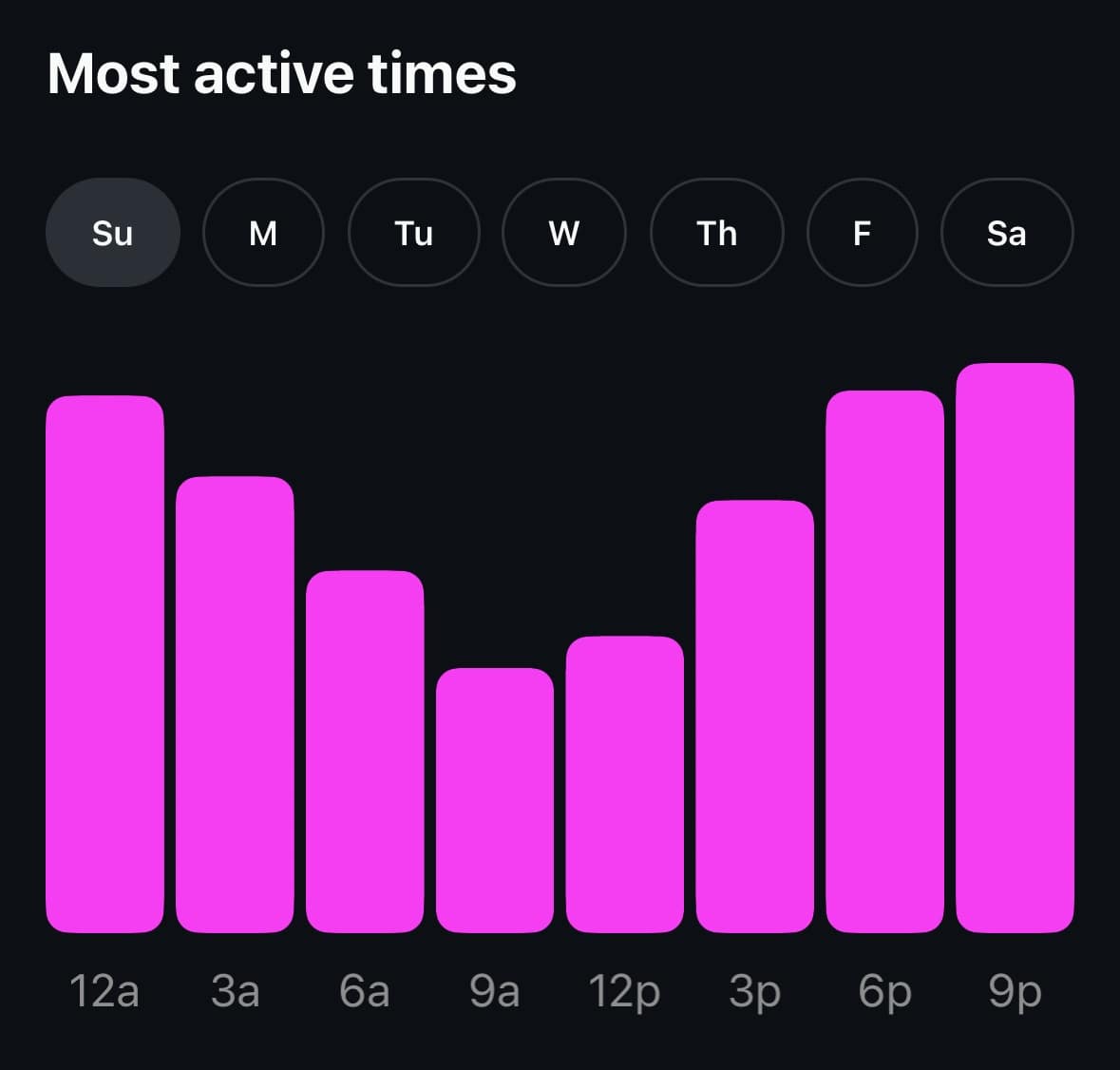
You’ll see when your audience is most active by day and hour. Start posting around those times and track the results.
2. Post consistently at different times.
Pick a few different time slots (morning, lunch, evening) and rotate your posts across them over a few weeks. Track which times generate the most likes, saves, shares, or comments.
3. Use A/B testing.
Take similar types of posts (e.g. two Reels or two carousels) and post them at different times on different days. Compare how they perform to identify which time slot drives more engagement.
4. Use a scheduling tool with advanced analytics capabilities.
Tools like Later, Buffer, Hootsuite, and Iconosquare will suggest best times based on your past performance. Some even allow automated time optimization. Tools like this speed up the testing process and give you actionable insights, so you can make improvements on the spot.
5. Adjust for time zones.
Again, if your audience is international, make sure you’re scheduling posts based on their local time, not yours. Use your insights to identify where your followers live, then tailor your timing accordingly.
Free and paid tools to discover the best time to post
You don’t have to guess your way to better engagement. There are tools that help you find the best time to post based on your actual audience behavior.
Some are free and built right into Instagram. Others offer advanced features like automated scheduling, AI-powered suggestions, and in-depth performance tracking. Whether you're just starting out or managing multiple accounts, there's a tool that fits.
Instagram Insights
This is Instagram’s native app. It’s free and offers essential data to guide your posting schedule. To access it, you’ll need a business or creator account.
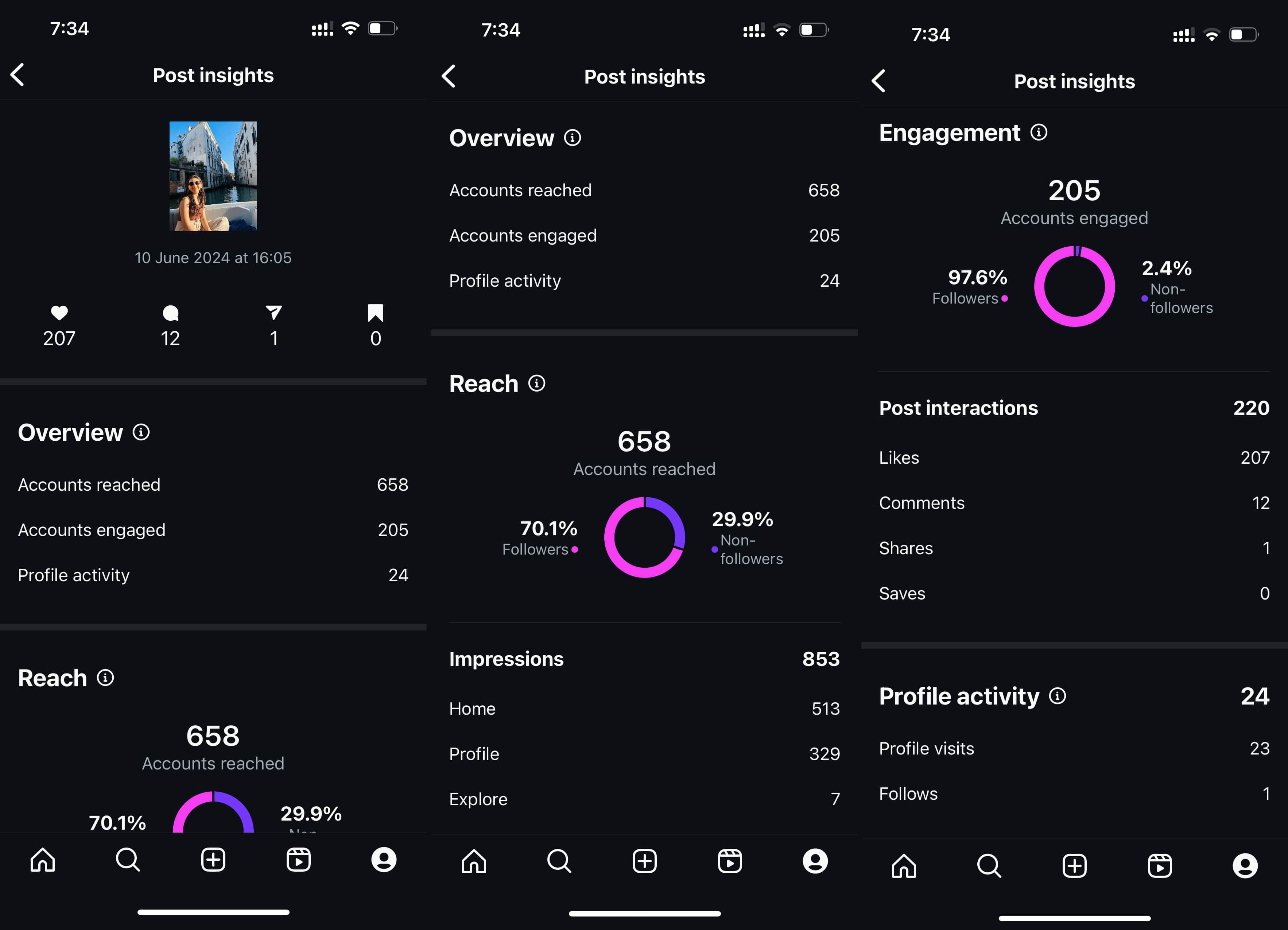
In addition to when your followers are most active, you’ll see info on:
- Views
- Followers
- Accounts reached
- Audience locations and demographics
- Top performing content
- External link taps
- Trends over time
These patterns help you align your posts with real audience behavior.
Best for: Beginners, solopreneurs, and small businesses.
Later Analytics
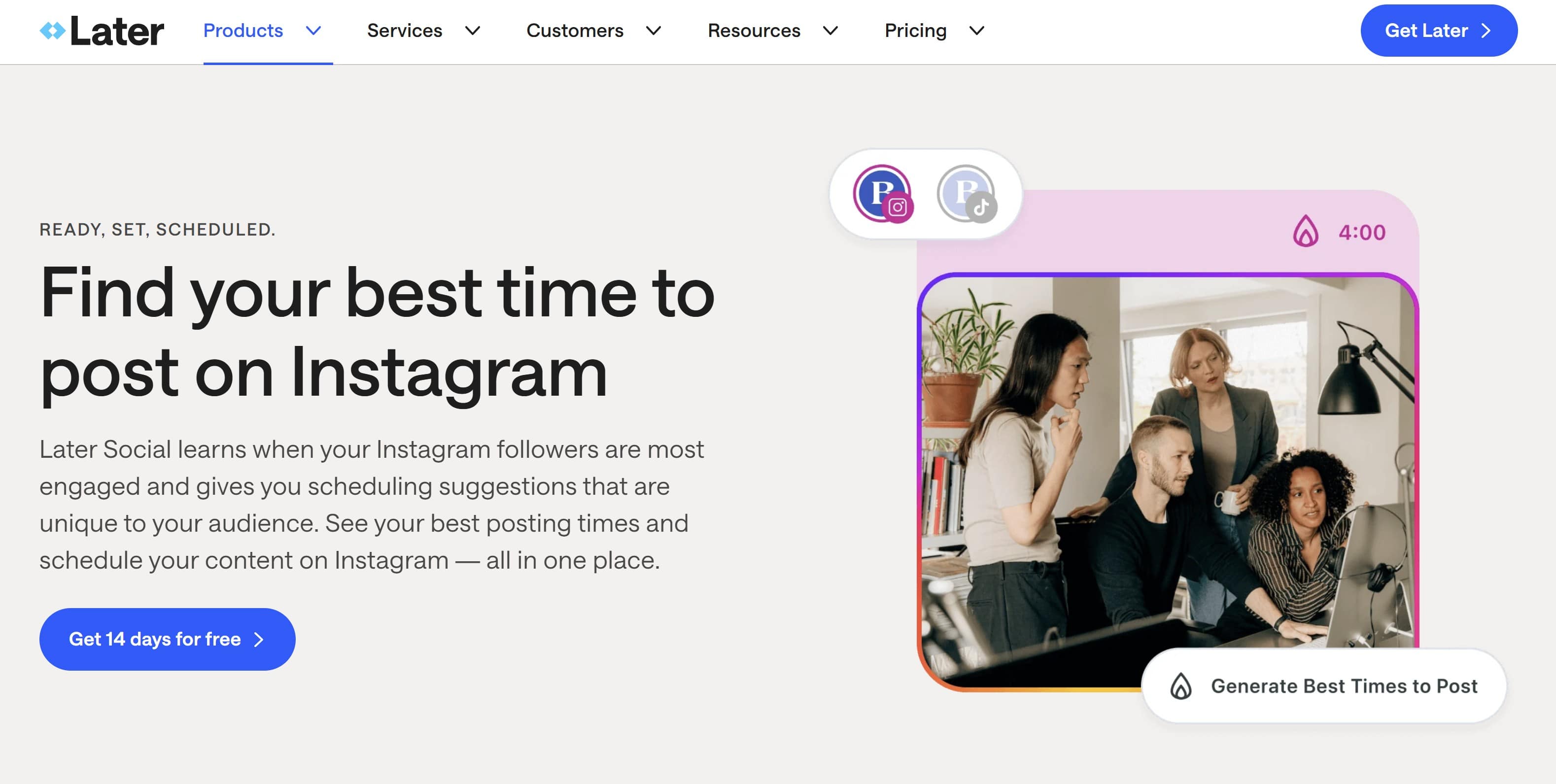
With Later’s Best Time to Post feature (available on its paid plans), it analyzes your historical post performance and identifies when your audience is most likely to engage. It gives you:
- A personalized best time chart
- Auto-scheduling suggestions on your calendar
- Performance breakdowns by post type, day, and time
Later also offers a free plan with basic analytics, so you can start testing without spending a dime. If you want a simple drag-and-drop scheduler with built-in data insights and a visual calendar, Later makes timing and planning feel intuitive.
Best for: Visual planners, content creators, and small-to-mid-sized brands.
Sprout Social
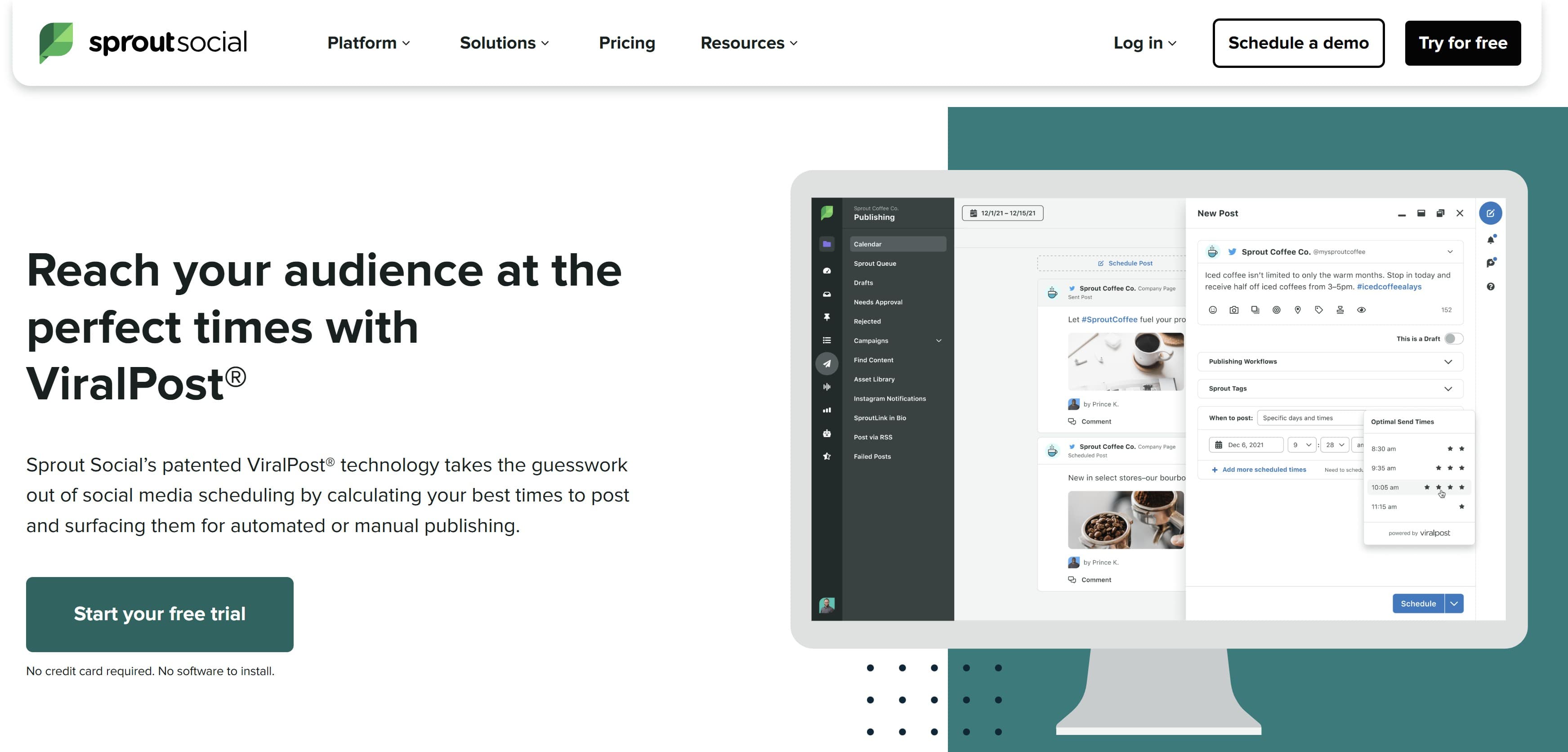
Sprout Social is a robust platform that goes beyond basic scheduling. It gives you advanced analytics and optimization tools to enhance your entire Instagram strategy.
Sprout analyzes up to 16 weeks of your audience's engagement data to recommend the most effective times to post. This way, you can schedule content when your audience is most active without having to think about it.
It also has an AI-driven tool called ViralPost®, which continuously refines posting time suggestions based on your audience's behavior, eliminating the need for manual analysis and ensuring your content reaches users at peak times.
Best for: Agencies, enterprise teams, and marketers managing multiple brands or clients.
Buffer
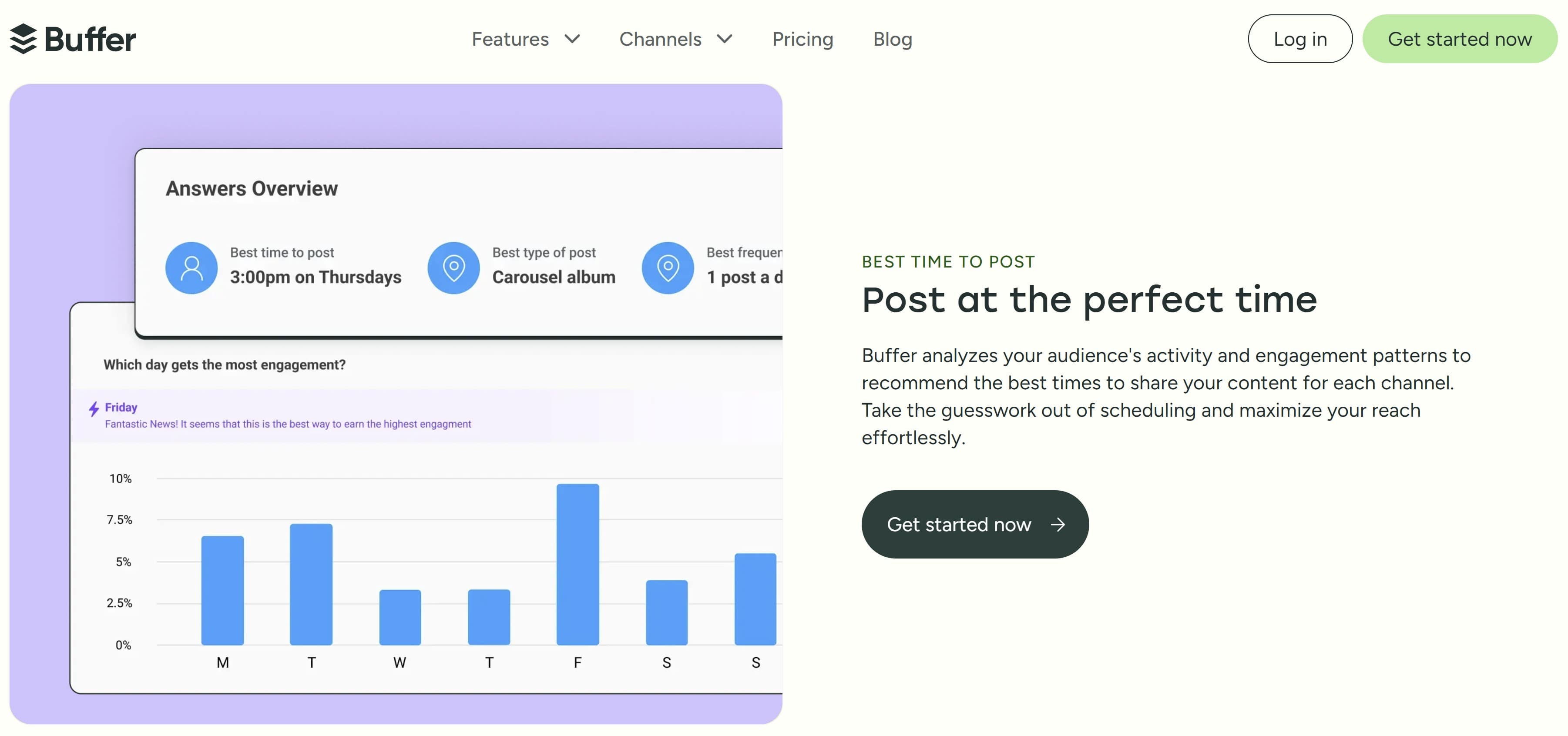
Buffer is a user-friendly platform that combines scheduling, analytics, and engagement tools to help you optimize your Instagram strategy. Buffer's analytics tool, Analyze, examines your historical post performance and follower activity to suggest personalized posting times.
It also gives you the ability to plan and schedule posts across various social media platforms, including Instagram, Facebook, Twitter, LinkedIn, and Pinterest, from a single dashboard.
Best for: Solo creators, small businesses, and teams seeking a streamlined scheduling and analytics solution.
Hootsuite
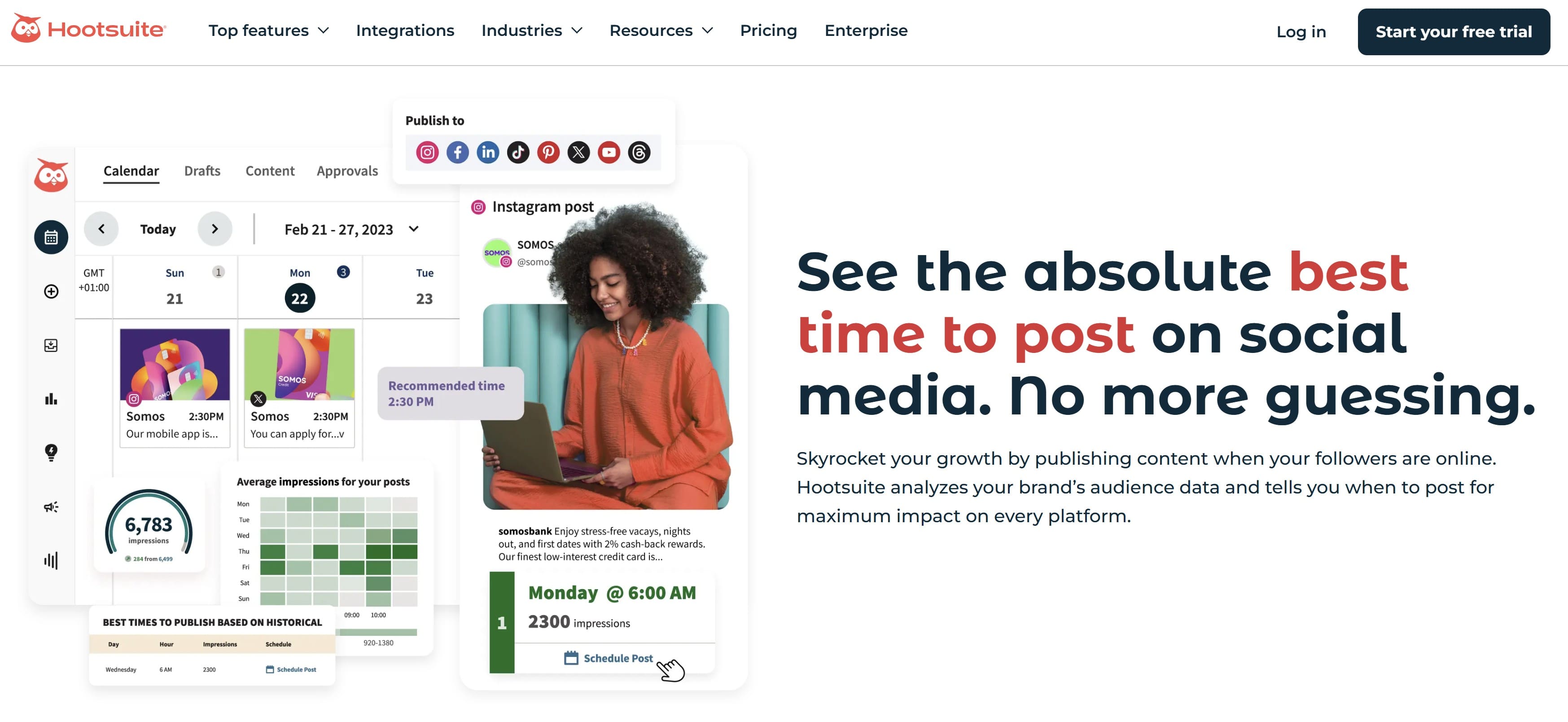
Hootsuite is a comprehensive social media management platform that offers advanced analytics and optimization tools to enhance your Instagram strategy while aligning it with the rest of your socials.
Hootsuite's "Best Time to Publish" feature analyzes your past performance and audience engagement patterns to recommend optimal posting times. From there, you can tailor your posting schedule based on specific objectives like increasing reach, boosting engagement, or driving traffic. Hootsuite provides suggestions aligned with your chosen goals.
Best for: Agencies, enterprise teams, and marketers managing multiple brands or clients.
Best posting time for different Instagram formats
Not all Instagram content behaves the same. Reels, Stories, Carousels, and Lives each serve different purposes—and they each follow different timing patterns for peak engagement. If you want to get the most out of your content, timing it to match how and when people consume it is key.
Here’s a breakdown of when to post based on format:
| Format | Best Times to Post | Best Days to Post |
|---|---|---|
| Reels | 6 a.m. – 9 a.m., 2 p.m. – 4 p.m., 6 p.m. – 9 p.m. | Tuesday, Wednesday, Thursday |
| Stories | 11 a.m. – 2 p.m. | Weekdays (Mon – Fri) |
| Carousels | 5 a.m. | Tuesday |
| Lives | 12 p.m., 7 p.m. – 9 p.m. | Monday – Friday |
Reels
Reels are high-reach, high-discovery content. They benefit from timing that aligns with when users are looking to be entertained: before work, mid-afternoon slump, or post-dinner chill time. So, the best time to post them are 6 a.m. to 9 a.m., 2 p.m. to 4 p.m., and 6 p.m. to 9 p.m.
The mid-week window (Tuesday through Thursday) is especially strong, likely because people are in a routine but still actively scrolling for fresh content.
Stories
Stories are casual, real-time, and often viewed during breaks, especially lunch. Since the Instagram algorithm shows Stories based on interest, posting right before or during midday spikes helps your content stay near the front of your followers’ queue.
Carousels
It sounds counterintuitive, but early morning is the sweet spot for Carousels. These posts tend to perform well when they have the full day to gain traction, and posting at 5 a.m. lets you catch early risers and ride the algorithm all day. Tuesdays offer a strong balance of attention and routine.
Lives
Lives thrive when people are free to watch in the moment. Midday (12 p.m.) and early evening (7 p.m. to 9 p.m.) are perfect for grabbing real-time attention. Weekdays outperform weekends here, since routines are more predictable and people are already in content-consumption mode.
Best time to post on Instagram by location
While most Instagram studies adjust data into local time zones, that doesn’t mean user behavior is the same everywhere. And if your audience spans multiple regions, this becomes even more important.
Cultural habits heavily influence when people scroll, so what works in New York or London might flop in Buenos Aires or Tokyo, even if you posted at the same time locally.
A few examples:
- Buenos Aires: The day starts later. People wake up late, eat dinner at 10 or 11 p.m., and often stay out past midnight, even on weekdays. A post that does well at 7 a.m. in Chicago might go totally ignored here.
- Middle East: During Ramadan, scrolling spikes after sunset when people break fast. Posting during local iftar hours can dramatically improve visibility.
- Spain: The workday is split with a long afternoon siesta. Mid-morning or early evening posts often outperform lunchtime slots.
A tip from our Instagram experts: If your audience is global or spread across different time zones, posting a few hours earlier than the expected peak can actually work to your advantage. It reduces competition and positions your post to be ready and waiting when users open the app for their first scroll.
Final thoughts
There’s no silver bullet when it comes to posting on Instagram. The best time to post depends on your audience, industry, content format, and even cultural habits. While global data can guide you, your own analytics will always be your most reliable compass.
Here’s the bottom line: If you want better results, stop guessing and start testing. Use insights, schedule smart, and tailor your timing to how your audience lives, scrolls, and buys.

